IB Biology Year 1 - Cell Energetics Test
1/33
There's no tags or description
Looks like no tags are added yet.
Name | Mastery | Learn | Test | Matching | Spaced |
|---|
No study sessions yet.
34 Terms

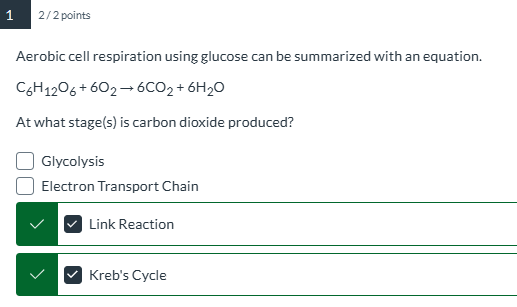
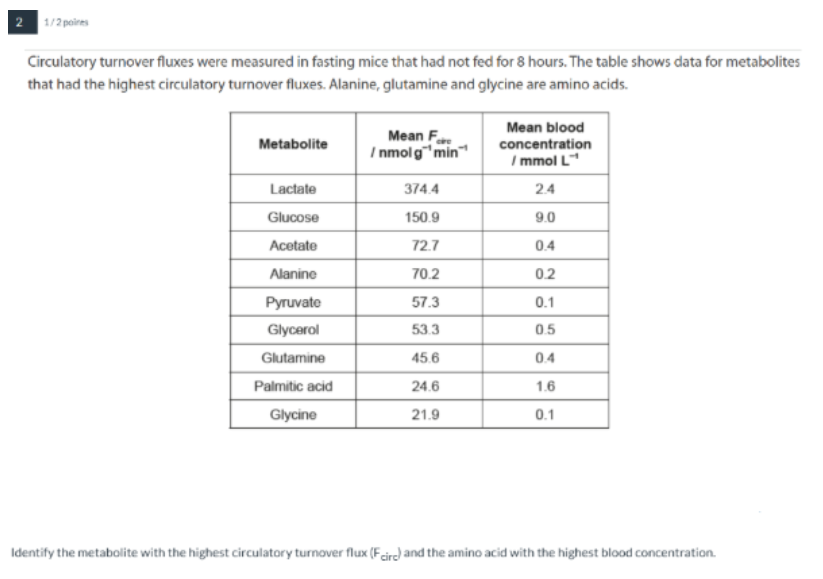
Lactate, Glutamine

D. The percentage of sugar remaining after 42 hours is greater for galactose than glucose.




What describes anaerobic cell respiration?
Glucose breaks down to pyruvates
What applies to chemiosmosis?

Which compound is a waste product of anaerobic respiration in humans?
Lactate
What ALL occurs during the link reaction?
There are three major enzymes that carry out three major steps in the link reaction. First, decarboxylation occurs by the removal of CO2 to change 3-carbon pyruvate into a 2-carbon. Next, oxidation occurs, with the removal of two electrons which are then accpeted by NAD, concerting it into reduced NAD. Finally, the binding of the acetyl group to a complex enzyme carrier occurs, the enzyme being coenzyme A. This makes citrate, which will start up the citric acid cycle.
Which molecule in the Krebs Cycle has the highest potential energy?
citrate
What is reduced by Photosystem I ?
NAD

NAD+ is reduced.
Why must the Calvin Cycle 'turn' six times?
The Calvin Cycle must "turn" six times to produce one molecule of glucose. This is because each turn of the cycle fixes only one carbon dioxide molecule, and glucose is a six-carbon molecule. Three turns of the cycle produce one three-carbon molecule of G3P, and two G3P molecules are needed to build one glucose molecule, requiring a total of six turns.
Chlorophyll a has a Rf value of 0.59, Chlorophyll b has a Rf value of 0.42, Carotene has a value of 0.98 while Xanthophyll has a value of 0.15.
Which pigment would travel furthest chromatography paper?
Carotene b/c has the highest value
Which process does not take place in the stroma of chloroplasts?
Reduction of NADP: This process occurs in the thylakoid membrane during the light-dependent reactions of photosynthesis.
Choose between a mitochondrion or a chloroplast. Describe adaptations of the organelle that allows them to be specialized for their specific functions.
The chloroplast contains a double membrane, which is explained by the endosymbiotic theory, stating that the choloroplast was once its own prokaryotic organism, until it got swallowed by a larger organism, to which the organisms lived in symbiosis with one another. The thylakoids inside the chloroplasts are arranged in stacks, called grana. The lamallae "connect" the grana together. Inside the thylakoids, substances to make pigment are found; the main pigment is chlorophyll A, which will reflect green light and absorb blue-violet light, while accessory pigments will absorb a broader range of color, giving plants their signature green color. In the membrane of the thylakoids, many of the light dependent reactions occur here for photosynthesis, which creates glucose. If light is not present, then the reactions will happen in the stroma of the chloroplast (a gel-like substance), using RuBP and CO2 to carboxylate RuBP with a carbon from CO2, which is done with the enzyme rubisco.
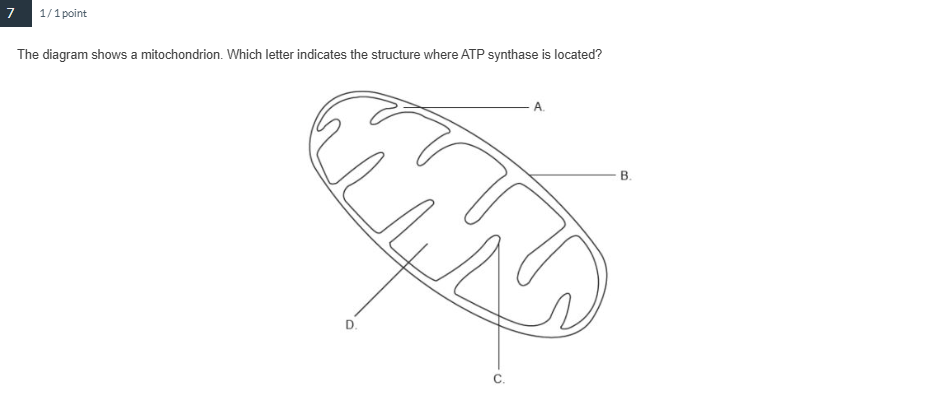
C
If a plant is exposed to light, which colour of light would lead to the lowest rate of oxygen release by a green plant?
Plants absorb blue and red light most efficiently for photosynthesis, while reflecting green light. Since photosynthesis relies on light absorption to produce oxygen, green light, which is largely reflected by the plant's chlorophyll, results in the lowest rate of oxygen production.
Why other options are incorrect:
Blue:
Blue light is absorbed efficiently by chlorophyll, leading to a high rate of photosynthesis and oxygen production.
Red:
Red light is also absorbed well by chlorophyll, contributing significantly to photosynthesis.
White:
White light contains all colors of the spectrum, including blue and red, which are absorbed by the plant, leading to a higher rate of oxygen production compared to green light.
Which molecules are "electron carriers" that deliver high energy electrons to an ETC?
FADH2
NADH
Which process occurs during the light-dependent reaction of photosynthesis?
ATP and O2 are produced

B b/c ATP does power the light-independent reactions of photosynthesis. In the light-independent reactions, also known as the Calvin cycle, ATP and NADPH, produced during the light-dependent reactions, are used to convert carbon dioxide into glucose. Essentially, ATP provides the energy needed to drive the Calvin cycle and synthesize sugars.
The Citric Acid Cycle begins with the condensation reaction (synthesis) of which two molecules?
oxaloacetate and acetyl-CoA
Mr. Calvin of Calvin Cycle fame has a first name... what is it?
Melvin
What happens when pyruvate is converted to acetyl CoA in the link reaction?
Phosphorylation
Which process produces the most ATP per molecule of glucose?
Aerobic respiration in leaf cells
Which compound is a waste product of anaerobic respiration in humans?
Lactate
Which reaction does not cause a net release of energy?
ADP combines with inorganic phosphate to form ATP
Which is a reduction reaction?
FAD changing to FADH2
Non-cyclic photophosphorylation generates NADPH, ATP and what other molecule when compared to cyclic photophosphorylation?
Atmospheric oxygen
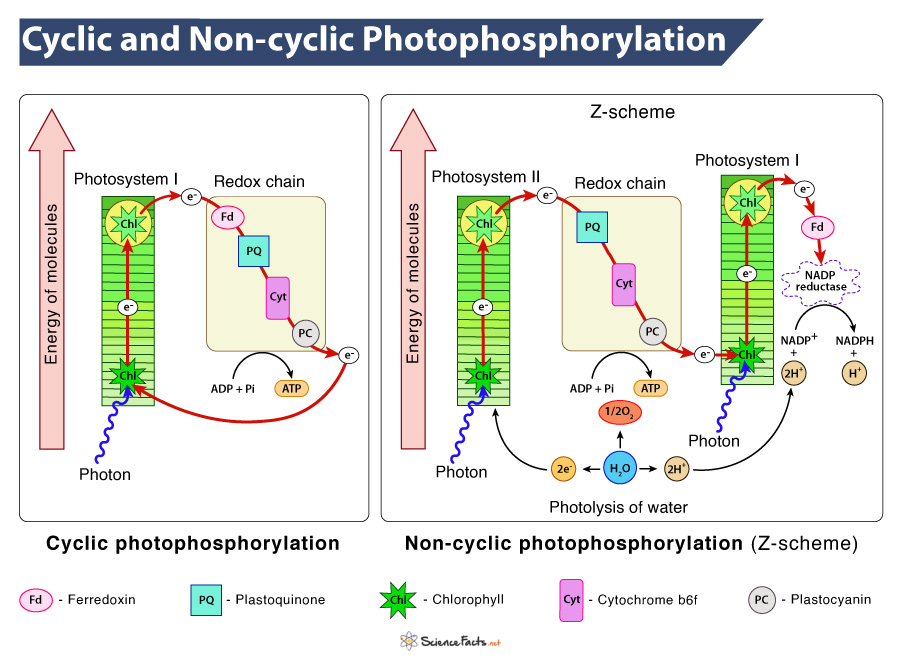
The enzyme ATP synthase has an essential role in aerobic cell respiration. Describe its location, function and type of transport involved.
In aerobic cell respiration, ATP synthase is located on the inner mitochondrial membrane (cristae). It plays an essential role in the electron transport chain by using the proton gradient created by the ETC. Protons (H⁺) flow down their concentration gradient from the intermembrane space back into the mitochondrial matrix through ATP synthase. This process, which occurs via facilitated diffusion, provides the energy needed to phosphorylate ADP into ATP.
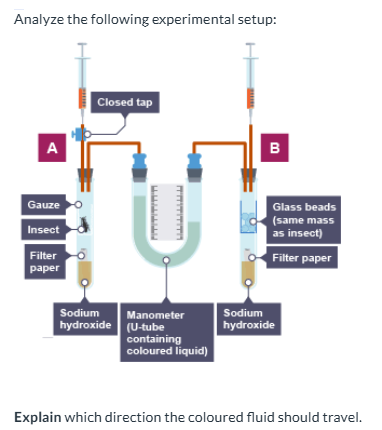
Due to the organism inside the tube respiring (the insect) and the tap on the same side of it being closed, the oxygen it inhales will be the only gas affecting the direction that the colored fluid would move, as the carbon dioxide is abosorbed by the sodium hydroxide and filter paper. Therefore, the colored fluid will move to the left, as more and more oxygen is sucked up by the insect.
What term is used for ATP synthesis coupled to electron transport and proton movement?
Chemiosmosis
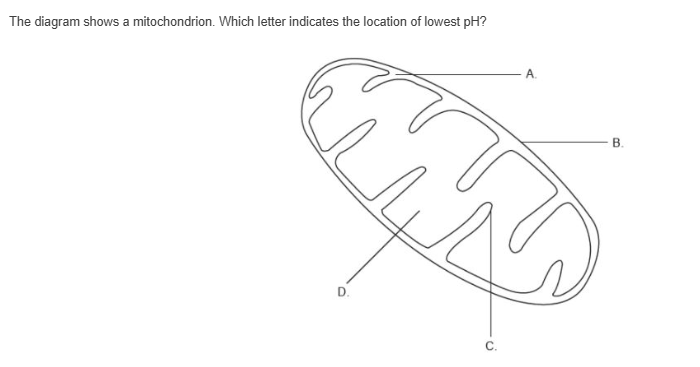
A
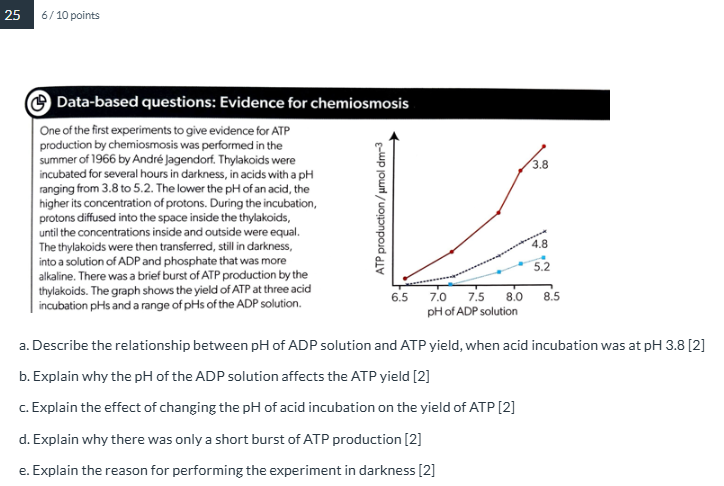
a. When acid incubation was at pH 3.8, so it was getting more basic, ATP production went up.
b. The more the pH of the ADP solutions turns acidic, the more it allows for an easier flow in and out of ATP synthase and want a larger difference from the acid and basic levels to propel flow. pH is the measure of H+ ions, so the more H+ ions the more acidic a solution is. Due to more acidity in the ADP solution, it caused a higher concentration of protons, which caused a greater output of ATP.
c. 3.8 has the most H+ concentration because it was sitting in the most acidic solution in the beginning
d. There is only a brief period of time where H+ ions and no H+ ions is the greatest divide. As they continuously flow in, this slows down and levels off.
e. It was done in the dark to force the production of energy to be a finite number of H+ because you are stopping both reactions but in the light it would be infinite number of H+